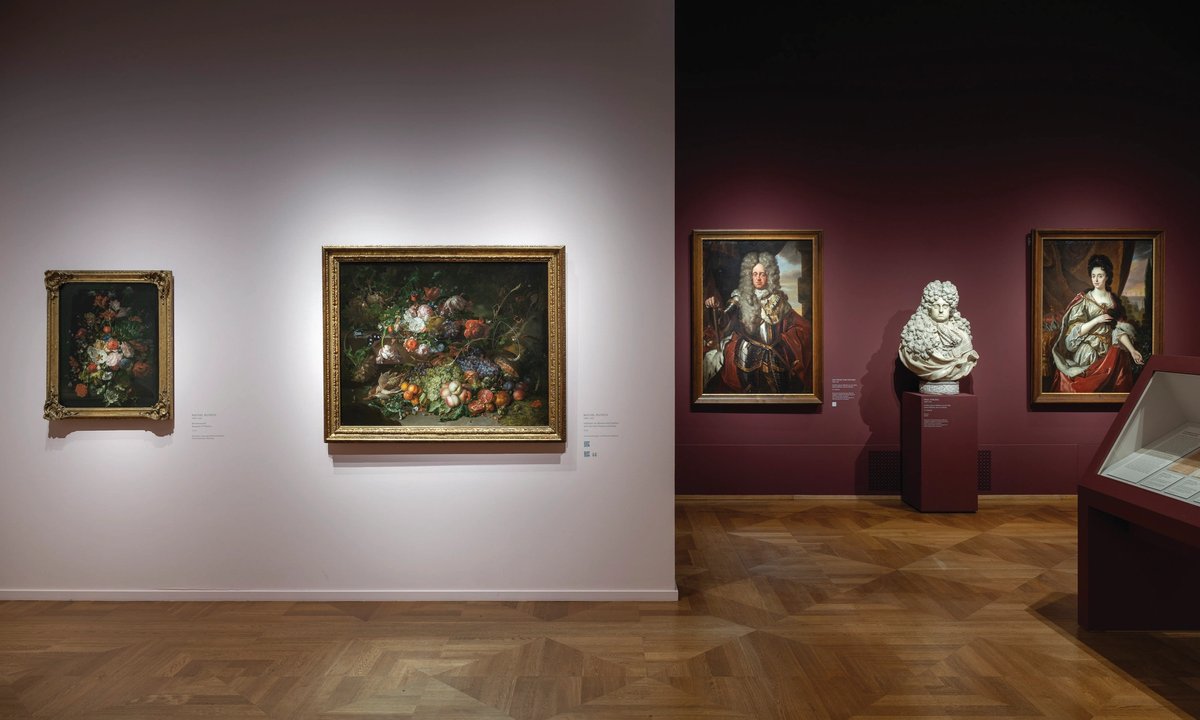Rachel Ruysch’s ability to combine a wide variety of plants "reaches a high point" in Still Life with Flowers and Fruits (1714) (pictured centre) Photo: Haydar Koyupinar, Bayerische Staatsgemäldesammlungen, Munich
Rachel Ruysch may be the most famous artist you have never heard of. Sprung into stardom at the tail end of the 17th century when Dutch art was at its peak, Ruysch (1664-1750) made her name painting highly specialised still-lifes, leaving behind a remarkable oeuvre of sumptuous floral works. In her mature period, in the first few decades of the 18th century, she was arguably Holland’s most celebrated painter.
The still-life genre went on to attract a number of stellar practitioners including Jean Siméon Chardin, Eugène Delacroix and Édouard Manet; not to mention the Cubists, Pablo Picasso, Georges Braque and Juan Gris. But Ruysch herself has lived on as a footnote, a major painter of what amounts to a minor sub-genre, known to scholars in the field but off the radar of the ordinary museum-goer. Now she is receiving blockbuster treatment in her first major survey, which has started out at the Alte Pinakothek Munich and will make its way later this year to the Toledo Museum of Art in Ohio and the Museum of Fine Arts, Boston.
Rachel Ruysch: Nature into Art certainly has all the makings of a great show. Ruysch’s life story is compelling, poignant and surprising, including everything from a lottery windfall to a mysterious-sounding sister, who painted floral still-lifes nearly indistinguishable from her own. Ruysch had ten children, six of whom lived to adulthood, and a seven-decade career that included many years as court painter to Johann Wilhelm II, Elector Palatine—a power player in the Holy Roman Empire. Johann, along with his Medici wife, amassed one of the era’s leading art collections, the cream of which went on to form a pillar of the Alte Pinakothek’s holdings.
The exhibition’s 57 paintings by the artist comprise over a third of her surviving work, taking us from the accomplished juvenilia of the early 1680s to her final paintings of the late 1740s. Not content with being thorough, the Munich curatorial team has filled out the show with hundreds of additional objects, in an installation meant to recall the natural collections and intellectual orbit of her father, Frederik Ruysch. A noted botanist and professor of anatomy, Frederik had broad scientific interests and expertise that fed into his daughter’s creations.
One drawback to the show—and to Ruysch’s own re-emergence—is the necessarily narrow range of the art. She really did only paint still-lifes, and those still-lifes are almost invariably dominated by flowers. Still, gallery after gallery of precisely rendered, carefully calibrated, utterly fabulous blooms—accentuated by the odd and outsize animal, or a banquet-size display of fruit—can have a sublime cumulative effect. Visually, the paintings are a sustained fusion of the fanciful with the natural, highly stylised but wholly realistic. And the combination, decade after decade, is a marvel.
The curators went on a treasure hunt to find some of these paintings, which were stashed away in museum depots, and the show begins with a recently re-emerged collaborative work—a 1692 portrait of Ruysch painted by the Dutchman Michiel van Musscher, with still-life elements by the artist herself. Acquired by New York’s Metropolitan Museum of Art in 2023, the painting shows a confident young woman bearing an easel, surrounded by her own meticulous and bountiful work.
Still-life painting garnered precious little respect in the highest artistic circles of the French Academy. In the so-called Hierarchy of Genres, devised in the 17th-century heyday of the Ancien Régime, the painting of fruit and flowers was at the very bottom, under landscapes, with history painting on top. The 17th-century Dutch artists typically played with that pecking order. And lowly still-life, which both celebrated and decorated Holland’s burgeoning domestic settings, enjoyed popularity and prestige for decades before Ruysch came along.
The first section of the show helpfully co-mingles works like Ruysch’s diminutive Flower Piece (around 1682), its bouquet conventionally set in a dark background, with works by her mentor, Willem van Aelst, and still-life predecessors such as Maria van Oosterwijck, a female trailblazer in the genre. Then we are led into the wonders, oddities, and occasional horrors of the early-modern naturalist’s cabinet, for which the curators draw on local collections. Here we see how Ruysch was inspired by—but also superseded—drawings of flora and fauna, such as a hand-coloured engraving of a Surinam toad, a bizarre amphibian native to the Dutch South American colony of Surinam. The creature found its way into an infernal Ruysch still-life of 1690 with a forest setting.
The glory of the show, and of Ruysch’s career, is the early 18th-century paintings, which are larger, brighter and richer than the work of previous decades. The exhibition reunites Still Life of Flowers in a Glass Vase on a Marble Ledge (1710), now in London’s National Gallery, with its original pendant Fruit Piece, on loan from a private collection.
Ruysch’s ability to combine a wide variety of plants, which set her apart from predecessors, reaches a high point in Still Life with Flowers and Fruits (1714). In what we might now describe as a celebration of biodiversity, the 4ft-wide painting, which once decorated Johann Wilhelm’s bedchamber, depicts more than 25 species, with origins around the globe.
Already handsomely paid, Ruysch struck it rich in 1723, when she and her family bought a winning lottery ticket. She all but gave up painting for over a decade, and the show winds down with her very late works, when she returned to the smaller scale of her youth, while forsaking that earlier age’s dark backgrounds. Posy of Flowers, with a Beetle on a Stone Ledge (1741) depicts a fragile nosegay instead of an expansive bouquet, set against an upward draft of transforming light.
I knew little about Ruysch’s work before I went, and I was enthralled while I was there. But after leaving, I developed doubts. Did those French tastemakers have a point?
Back in 21st-century Munich, I considered that Ruysch’s work was essentially—even merely—decorative, like the highest order of wallpaper. And it seemed that even a superlative show about this kind of art can be very good, but never truly great.
Andreas Kilb in the Frankfurter Allgemeine writes: “Ruysch’s dramatic flower depictions are not a memento mori. But from the very beginning, death shares the stage with this spectacle of beauty.” He adds that the lizards in the pictures seem “to detach themselves from the floral arrangements—a delicate dance between the present moment and eternity.”Franz Zelger, writing in the Swiss newspaper Neue Zürcher Zeitung, says that “it is striking that [Ruysch’s late paintings] not only show the date of their creation and the signature, but also record the age of the painter, probably to show that she could still perform at the highest level.”
• Rachel Ruysch: Nature into Art, Alte Pinakothek, Munich, until 16 March, Curators: Bernd Ebert, Robert Schindler and Anna C. Knaap, Tickets: €12 (concessions available)
Our rating: 4 stars
The works: 3 stars
The show: 5 stars
Bequest of modern paintings and sculpture to tour American cities
Featuring 82 works by 26 artists, this New York show tells the story of the short-lived style and its main protagonists
Painters from Brangwyn to Nash paid homage to the masterpiece, all illustrated on the Art UK site
The deep and life-long influence of the Old Master on the Modernist is explored in an exhibition that pairs their works at the Kunstmuseum Basel

